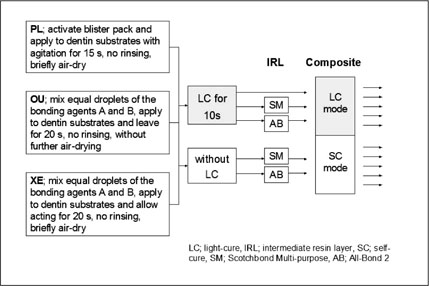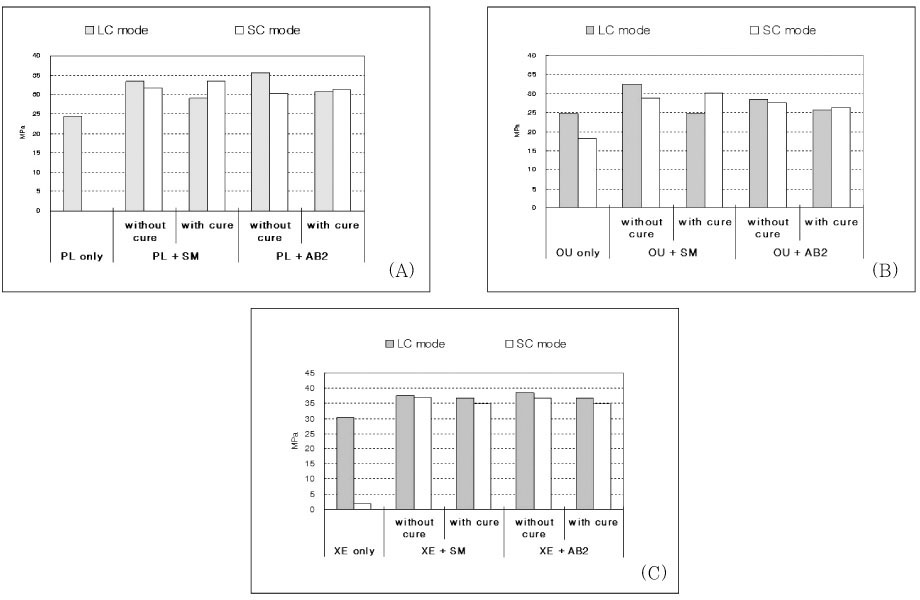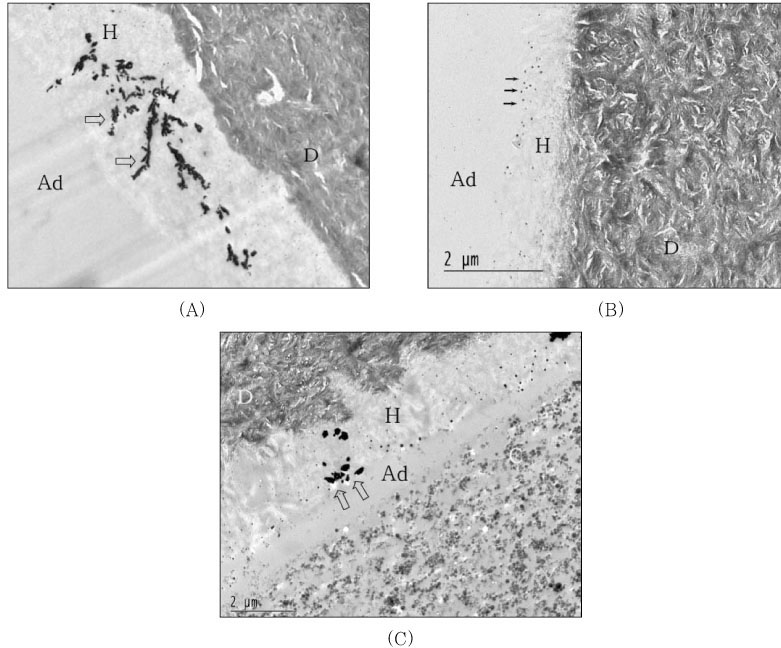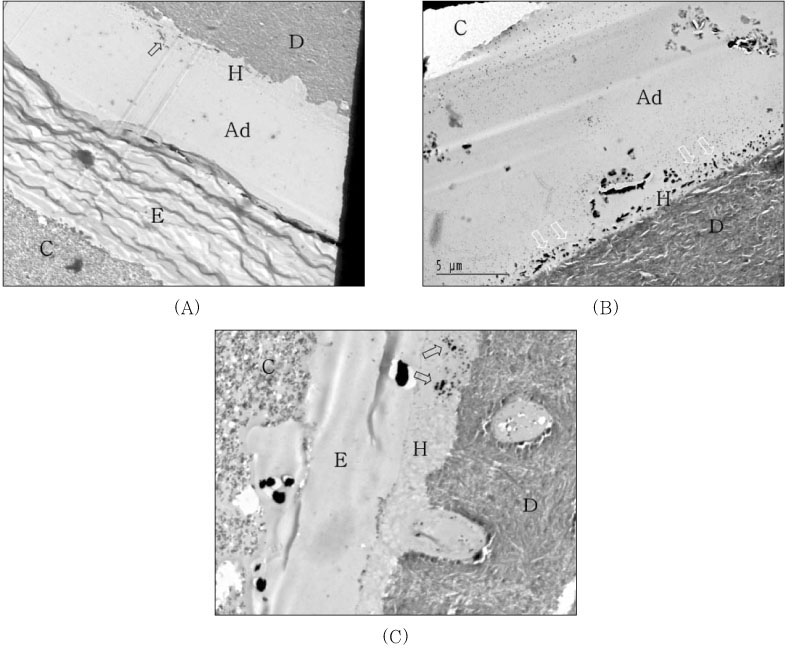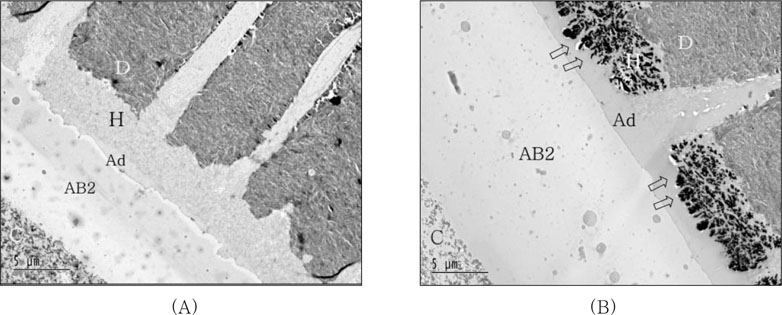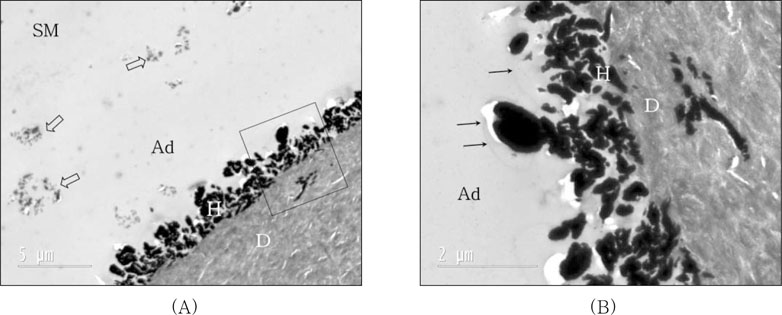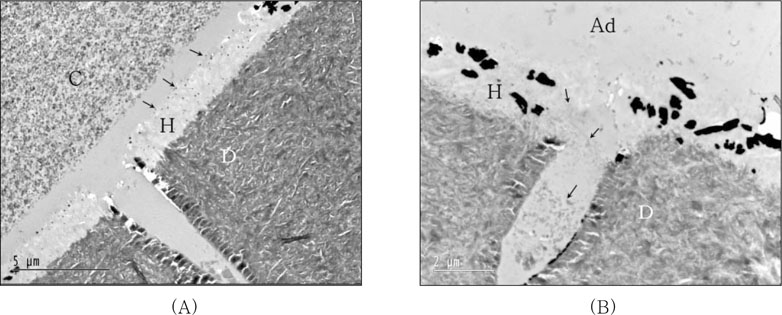J Korean Acad Conserv Dent.
2007 Jul;32(4):313-326. 10.5395/JKACD.2007.32.4.313.
Effect of the additional application of a resin layer on dentin bonding using single-step adhesives
- Affiliations
-
- 1Department of Conservative Dentistry, Division of Dentistry, Graduate School of Kyung-Hee University, Korea. psangjin@khu.ac.kr
- KMID: 2175893
- DOI: http://doi.org/10.5395/JKACD.2007.32.4.313
Abstract
- The purpose of this study was to prove that an intermediate resin layer (IRL) can increase the bond strength to dentin by reducing the permeability of single-step adhesives. Flat dentin surfaces were created on buccal and lingual side of freshly extracted third molar using a low-speed diamond saw under copious water flow. Approximately 2.0 mm thick axially sectioned dentin slice was abraded with wet #600 SiC paper. Three single-step self-etch adhesives; Adper Prompt L-Pop (3M ESPE, St Paul, MN, USA), One-Up Bond F (Tokuyama Corp, Tokyo, Japan) and Xeno III (Dentsply, Konstanz, Germany) were used in this study. Each adhesive groups were again subdivided into ten groups by; whether IRL was used or not; whether adhesives were cured with light before application of IRL or not; the mode of composite application. The results of this study were as follows; 1. Bond strength of single-step adhesives increased by an additional coating of intermediate resin layer, and this increasement was statistically signigicant when self-cured composite was used (p < 0.001). 2. When using IRL, there were no difference on bond strengths regardless the curing procedure of single-step adhesives. 3. There were no significant difference on bond strengths between usage of AB2 or SM as an IRL. 4. The thickness of hybrid layer was correlated with the acidity of adhesive used, and the nanoleakage represented by silver deposits and grains was examined within hybrid and adhesive layer in most of single-step adhesives. 5. Neither thickness of hybrid layer nor nanoleakage were related to bond strength.
Keyword
MeSH Terms
Figure
Cited by 2 articles
-
Quantitative comparison of permeability in the adhesive interface of four adhesive systems
Juhea Chang, Keewook Yi, Hae-Young Kim, In Bog Lee, Byeong Hoon Cho, Ho-Hyun Son
J Korean Acad Conserv Dent. 2009;34(1):51-60. doi: 10.5395/JKACD.2009.34.1.051.Effect of film thickness of resin cement on bonding efficiency in indirect composite restoration
Sang-Hyuck Lee, Gi-Woon Choi, Kyung-Kyu Choi
J Korean Acad Conserv Dent. 2010;35(2):69-79. doi: 10.5395/JKACD.2010.35.2.069.
Reference
-
1. Kanca J. Improving bond strength through acid etching of dentin and bonding to wet dentin surfaces. J Am Dent Assoc. 1992. 123:35–42.
Article2. Bertolotti R. total-etch the rational dentin bonding protocol. J Esthet Dent. 1991. 3:1–6.3. van Meerbeek B, Perdigao J, Lambrechts P, Vanherle G. The clinical performance of adhesives. J Dent. 1998. 26:1–20.
Article4. Frey O. Creating a reliable bond. An all-in-one system. Am J Dent. 2000. 85D–87D.5. Swift EJ Jr, Perdigao J, Combe EC, Simpson CH 3rd, Nunes MF. Effects of restorative and adhesive curing methods on dentin bond strengths. Am J Dent. 2001. 14:137–140.6. Sanares AM, Itthagarun A, King NM, Tay FR, Pashley DH. Adverse surface interactions between one-bottle light-cured adhesives and chemical-cured composites. Dent Mater. 2001. 17:542–556.
Article7. Schiltz MY, Suh BI. Effect of pH of single-bottle adhesives on shear bond strength. J Dent Res. 2001. 80(special issue):50.8. Tay FR, Pashley DH, Suh BI, Carvalho RM, Itthagarun A. Single-step adhesives are permeable membranes. J Dent. 2002. 30:371–382.
Article9. Tay FR, Pashley DH. Aggressiveness of contemporary self-etching systems. I: Depth of penetration beyond dentin smear layers. Dent Mater. 2001. 17:296–308.10. Pashley DH, Tay FR. Aggressiveness of contemporary self-etching adhesives. Part II: etching effects on unground enamel. Dent Mater. 2001. 17:430–444.
Article11. Tay FR, Pashley DH, Yiu CK, Sanares AM, Wei SH. Factors contributing to the incompatibility between simplified-step adhesives and chemically-cured or dual-cured composites. Part I. Single-step self-etching adhesive. J Adhes Dent. 2003. 5:27–40.12. Tay FR, Suh BI, Pashley DH, Prati C, Chuang SF, Li F. Factors contributing to the incompatibility between simplified-step adhesives and chemically-cured or dual-cured composites. Part II. Single-bottle, total-etch adhesive. J Adhes Dent. 2003. 5:91–105.13. Tay FR, King NM, Suh BI, Pashley DH. Effect of delayed activation of light-cured resin composites on bonding of all-in-one adhesives. J Adhes Dent. 2001. 3:207–225.14. Tay FR, Pashley DH. water-treeing- A potential mechanism for degradation of dentin adhesives. Am J Dent. 2003. 16:6–12.15. Cheong C, King NM, Pashley DH, Ferrari M, Toledano M, Tay FR. Incompatibility of self-etch adhesives with chemical/dual-cured composites: two-step vs one-step systems. Oper Dent. 2003. 28:747–755.16. Carvalho RM, Pegoraro TA, Tay FR, Pegoraro LF, Silva NR, Pashley DH. Adhesive permeability affects coupling of resin cements that utilise self-etching primers to dentine. J Dent. 2004. 32:55–65.
Article17. Tay FR, Moulding KM, Pashley DH. Distribution of nanofillers from a simplified-step adhesive in acid-conditioned dentin. J Adhes Dent. 1999. 1:103–117.18. Tay FR, Pashley DH, Yoshiyama M. Two modes of nanoleakage expression in single-step adhesives. J Dent Res. 2002. 81:472–476.
Article19. Sano H, Takatsu T, Ciucchi B, Horner JA, Matthews WG, Pashley DH. Nanoleakage: leakage within the hybrid layer. Oper Dent. 1995. 20:18–25.20. Sano H, Yoshiyama M, Ebisu S, Burrow MF, Takatsu T, Ciucchi B, Carvalho R, Pashley DH. Comparative SEM and TEM observations of nanoleakage within the hybrid layer. Oper Dent. 1995. 20:160–167.21. Suh BI. Current issues in adhesion dentistry; Classification, curing, compatibility and sensitivity. 2005. Bisco Inc;26. (in Press).22. Choi KK, Kim SW, Choi HY. Effect of filler addition to bonding agents on the physical properties and the bond strength to bovine teeth. 2002. The First International Congress on Adhesive Dentistry IAD;434. Program and Abstracts.23. Reis AF, Arrais CAG, Novaes PD, Carvalho RM, De Goes MF, Giannini M. Ultramorphological analysis of resin-dentin interfaces produced with water-based single-step and two-step adhesives; Nanoleakge expression. Oper Dent. 2005. in Press.24. Hashimoto M, Ohno H, Kaga M, Endo K, Sano H, Oguchi H. In vivo degradation of resin-dentin bonds in humans over 1 to 3 years. J Dent Res. 2000. 79:1385–1391.
Article25. Tanaka J, Ishikawa K, Yatani H, Yamashita A, Suzuki K. Correlation of dentin bond durability with water absorption of bonding layer. Dent Mater J. 1999. 18(1):11–18.
Article26. Yiu CK, King NM, Pashley DH, Suh BI, Carvalho RM, Carrilho MR, Tay FR. Effect of resin hydrophilicity and water storage on resin strength. Biomaterials. 2004. 25:5789–5796.
Article27. Chang YI, Choi KK, Park SJ. Compatibility between two-step self-etching adhesives and composites with different curing mode. J Korean Acad Conserv Dent. 2005. in Press.28. Sano H, Yoshikawa T, Pereira PN, Kanemura N, Morigami M, Tagami J, Pashley DH. Long-term durability of dentin bonds made with a self-etching primer, in vivo. J Dent Res. 1999. 78:906–911.
Article29. Göhring TN, Schönenberger KA, Lutz F. Potential of restorative systems with simplified adhesives: Quantitative analysis of wear and marginal adaptation in vitro. Am J Dent. 2003. 16:275–282.
- Full Text Links
- Actions
-
Cited
- CITED
-
- Close
- Share
- Similar articles
-
- The effect of bonding resin on bond strength of dual-cure resin cements
- Effect of an intermediate bonding resin and flowable resin on the compatibility of two-step total etching adhesives with a self-curing composite resin
- Effect of 2% chlorhexidine application on microtensile bond strength of resin composite to dentin using one-step self-etch adhesives
- The effect of various bonding systems on the microtensile bond strength of immediate and delayed dentin sealing
- Influence of adhesive application on shear bond strength of the resin cement to indirect resin composite

